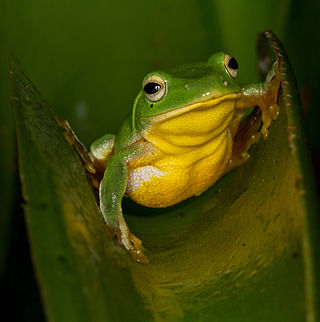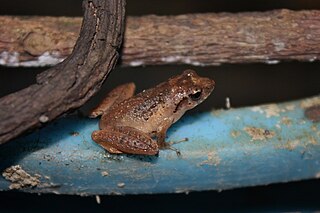
The Rhacophoridae are a family of frogs in tropical sub-Saharan Africa, South India and Sri Lanka, Japan, northeastern India to eastern China and Taiwan, south through the Philippines and Greater Sundas, and Sulawesi. They are commonly known as shrub frogs, or more ambiguously as "moss frogs" or "bush frogs". Some Rhacophoridae are called "tree frogs". Among the most spectacular members of this family are numerous "flying frogs".

The Rhacophorinae are a subfamily of frogs in the family Rhacophoridae. They range from tropical Africa and Asia to temperate China and Japan.
Zhangixalus chenfui, also known as Chinese whipping frog or Chenfu's treefrog, is a species of frog in the family Rhacophoridae endemic to China where it is found in Sichuan, Guizhou, Hubei, and Fujian provinces. It has been observed between 900 and 3000 meters above sea level.
Zhangixalus dorsoviridis, also known as the green-back treefrog, is a species of frog in the family Rhacophoridae that is found in northern Vietnam and southern China (Yunnan). It may be confused with Rhacophorus nigropunctatus.
Zhangixalus yaoshanensis is a species of frog in the family Rhacophoridae. It is endemic to China, where its type locality is Dayao Mountain, Jinxiu County, Guangxi Province.

Zhangixalus aurantiventris is a species of frog in the family Rhacophoridae. It is endemic to Taiwan. It is known from scattered localities across Taiwan at low to mid altitudes.

The Chinese flying frog or Chinese gliding frog is a species of tree frog in the family Rhacophoridae found in China, Laos, Burma, and Vietnam. It is also known as Blanford's whipping frog, large treefrog, and Denny's whipping frog.

Zhangixalus moltrechti is a species of frog in the family Rhacophoridae. It is endemic to Taiwan, where it has a wide distribution in hilly areas. Common names Moltrecht's green treefrog, Moltrecht's treefrog, Taiwan treefrog, and Nantou flying frog have been coined for it.

Zhangixalus prasinatus is a species of frog in the family Rhacophoridae endemic to northern Taiwan. It has been observed between 400 and 600 meters above sea level.

The Taipei tree frog is a species of frog in the family Rhacophoridae. It is endemic to central and northern Taiwan. It is a medium-sized tree frog; females are 4.5–5.5 cm (1.8–2.2 in) in snout-vent length, and males are slightly smaller 3.5–4.5 cm (1.4–1.8 in).

Gracixalus is a genus of shrub frogs from south-eastern Asia.
Zhangixalus yinggelingensis is a species of frog in the family Rhacophoridae endemic to Yinggeling National Nature Reserve, Hainan, China. Its specific name refers to the type locality, Yinggeling, a mountain range in central Hainan.

Liuixalus is a small genus of rhacophorid frogs that are distributed in southern China. Some species now in Liuixalus were originally placed in Philautus. It is thought to be the most basal genus in the Rhacophorinae.

Zhangixalus is a genus of frogs in the subfamily Rhacophorinae, family Rhacophoridae. They are collectively known as Zhang's treefrogs. They occur in the Eastern Himalayas, southern China, Taiwan, Japan, and southeast Asia.

Boulenophrys is a genus of frogs in the family Megophryidae. They occur in the China, Mainland Southeast Asia and Northeast India. It had been placed variously as a subgenus or synonymy of Megophrys. Dubois, Ohler and Pyron first recognized that Panophrys is preoccupied and employed Boulenophrys as the generic name rather than Tianophrys under the Principle of First Revisor.
Zhangixalus leucofasciatus, the white-striped tree frog, is a species of frog in the family Rhacophoridae. It is endemic to China and has been osberved in Guangxi Province and Guizhou Province.
Zhangixalus pinglongensis, the Pinglong tree frog, is a species of frog in the family Rhacophoridae. It is endemic to Guangxi Province, China and suspected in northeastern Vietnam. It has been observed between 1500 and 2000 meters above sea level in evergreen forests.
Zhangixalus hongchibaensis, the Wuxi tree frog, is a frog in the family Rhacophoridae. Scientists know it from the type locality: Hongchiba in Wuxi County, Chongqing Province, China. It has been observed 1747 meters above sea level.
Zhangixalus lishuiensis is a species of frog in the family Rhacophoridae. Scientists know it exclusively from the type locality: Fengyang Forest Station in Zhejiang Province, China. It has been observed 1100 meters above sea level.
Gracixalus jinggangensis, the Jinggang tree frog, is a species of frog in the family Rhacophoridae. It is endemic to China, where it has been observed on Mount Jinggan in Jiangxi Province.











